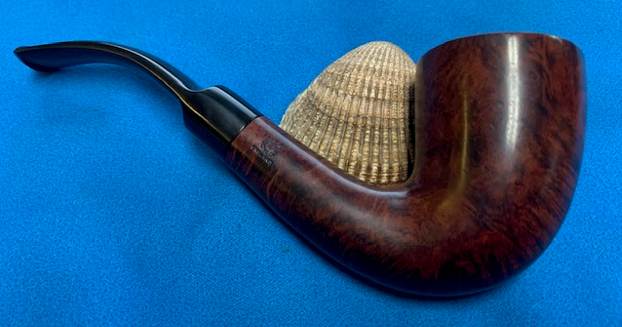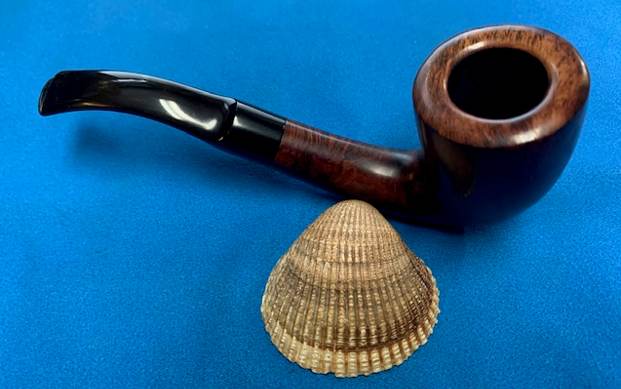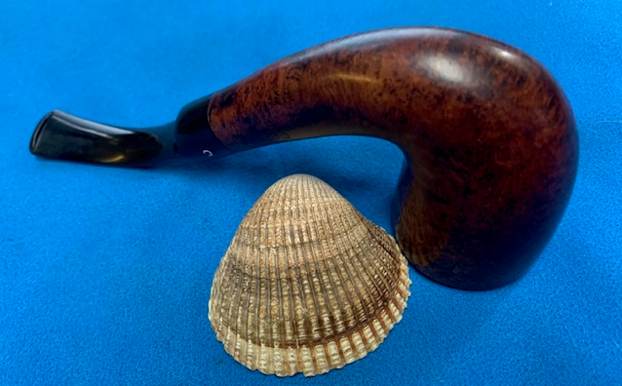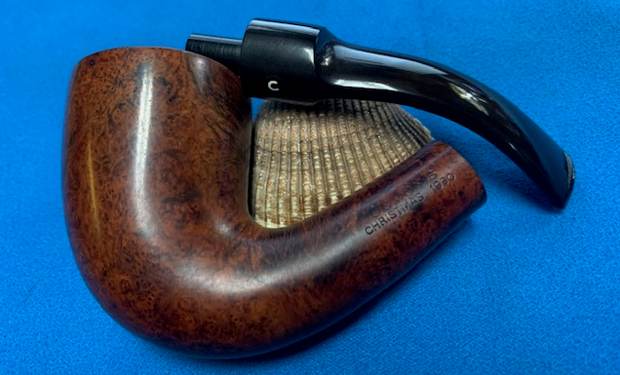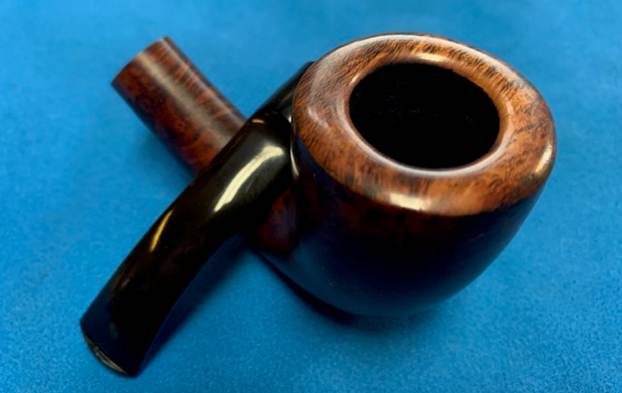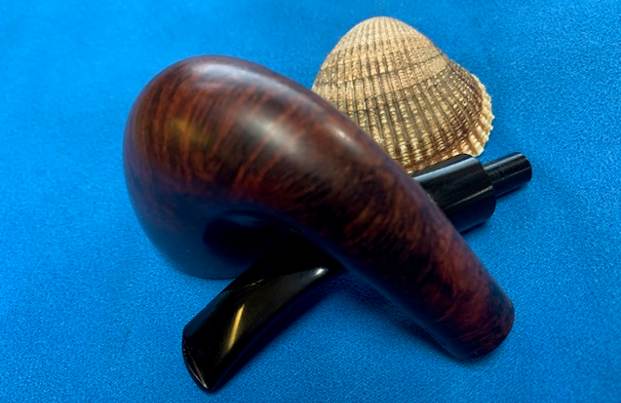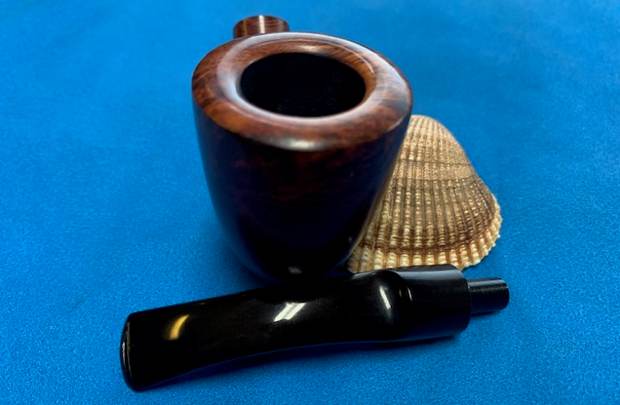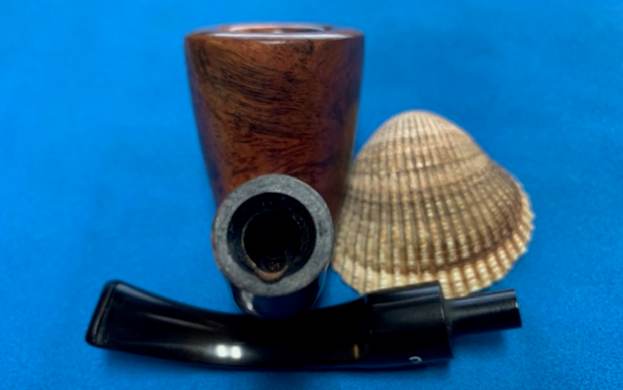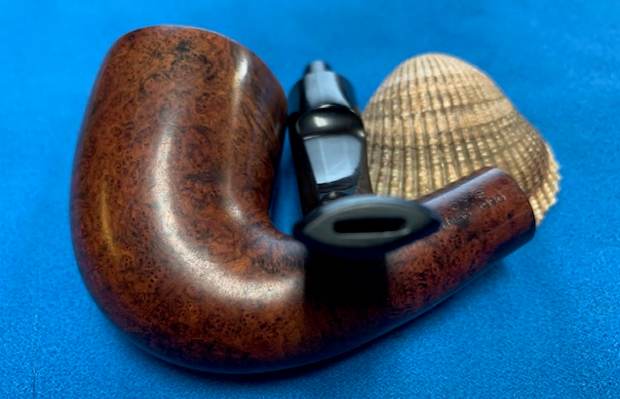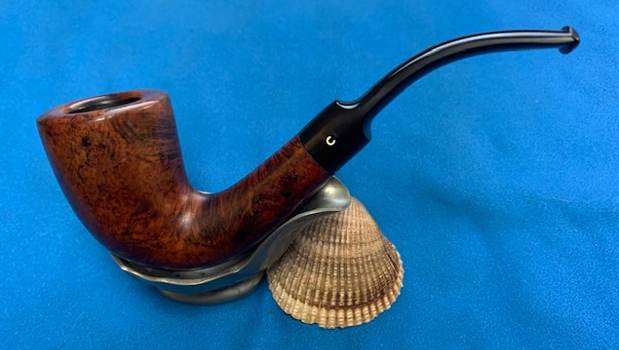Blog by Steve Laug
I thought I would continue with the same tack I took on the Wenhall and take you through my process of working on each pipe that we purchase. Jeff has set up a spread sheet to track where the pipe came from, the date of purchase and what we paid for it so that we know what we have invested in the pipe before we even work on it. This takes a lot of the guess work out of the process. This particular pipe was purchased on 01/23/2023 from a seller in Cincinnati, Ohio, USA. I also want you to understand why we take the photos we do. It is not accidental or chance as the photos have been taken to help me make an assessment of the pipe Jeff sees before he starts his clean up work. We do this to record the condition that the pipe was in when received it and to assess what kind of work will need to be done on. When I look at these photos this is what I see.
- The finish is dirty with dark streaks around the bowl and shank. I am not sure if they are stain or just grim. Underneath there appears to be some excellent grain. The finish is also dull and quite lifeless looking.
- The rim top is crowned and dirty. There is some lava overflow from the cake in the bowl on the top as well as some of the dark streaks. There also appears to be some scratching on the right top of the rim.
- The bowl has a thick cake in it but the inner edge of the bowl actually looks to be undamaged from what I can see at this point. There does not appear to be any burning or reaming damage to the edges of the bowl.
- The stem is vulcanite and has a single piece C inserted logo on the left side of the saddle portion.
- The stem had some oxidation and tooth marks and chatter that are visible in the photos below. Nothing to deep but nonetheless present.
Overall my impressions of this Calabash shaped pipe is that it is a beauty that once cleaned up will look pretty amazing. The cake does not seem to hide any burns or checking and the exterior of the bowl does not show any hot spots or darkening. The fact that it is a Christmas pipe from Comoy’s with a date in the stamp is a plus. The photos below confirm the assessment above.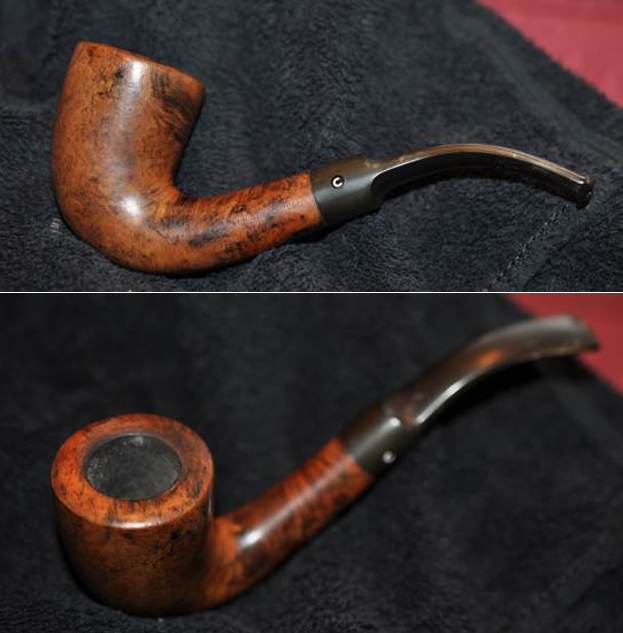 Jeff took close up photos so that I could have a clearer picture of the condition of the bowl and rim edges and top. The rim top photos confirm my assessment above. The cake in the bowl is quite thick and the rim top has light lava and debris on it as well as some kind of film that will need to come off. You can also see the condition of the inner and outer edges of the rim. This is what I look for when assessing a pipe. While there is lava and darkening there is no visible burn damage at this point and the previous reaming has not left damage either. The bowl is still fairly round. There are some scratches in the surface of the crowned rim top.
Jeff took close up photos so that I could have a clearer picture of the condition of the bowl and rim edges and top. The rim top photos confirm my assessment above. The cake in the bowl is quite thick and the rim top has light lava and debris on it as well as some kind of film that will need to come off. You can also see the condition of the inner and outer edges of the rim. This is what I look for when assessing a pipe. While there is lava and darkening there is no visible burn damage at this point and the previous reaming has not left damage either. The bowl is still fairly round. There are some scratches in the surface of the crowned rim top.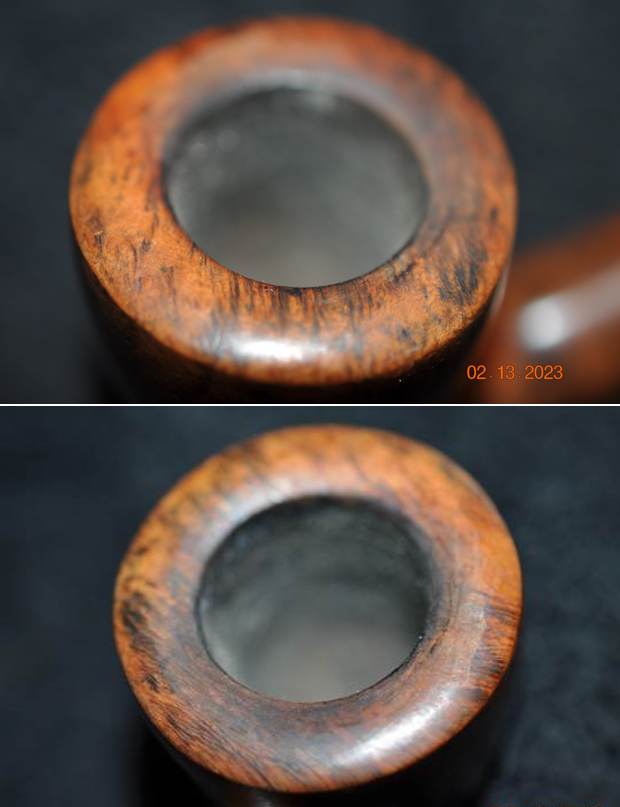 His photos of the stem surface confirmed and heightened my assessment of the condition. You can see the oxidation and scratches in the middle top of the stem surface. Note also the tooth marks on the edge of the button on both sides.
His photos of the stem surface confirmed and heightened my assessment of the condition. You can see the oxidation and scratches in the middle top of the stem surface. Note also the tooth marks on the edge of the button on both sides.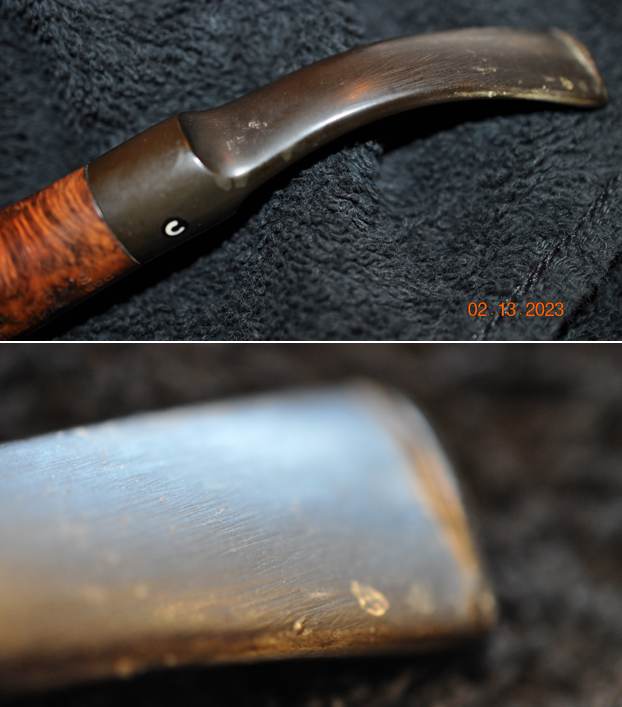
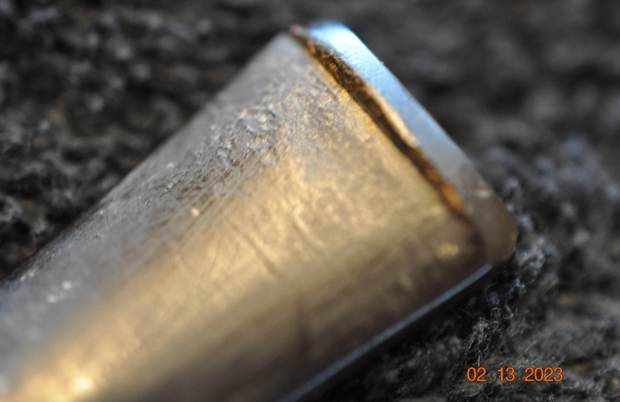 I always ask Jeff to take photos of the sides and heel of the bowl. While this definitely shows the grain patterns around a bowl it also allows me to do a more thorough assessment of the condition of the briar and the finish. In this case I look at the finish around the dark streaks around the bowl sides to confirm it was not just the stain on the bowl to highlight grain. It seems to be dark grime on the surface but the cleaning would further clarify what I was seeing. There were no cracks or splits following the grain or coming down from the rim edges. I also look for flaws in the grain as those can also hide cracks or damage. In this case the bowl exterior is sound and should clean up very well. I love the grain patterns that appear to have birdseye on the sides and cross grain on the front and back of the bowl.
I always ask Jeff to take photos of the sides and heel of the bowl. While this definitely shows the grain patterns around a bowl it also allows me to do a more thorough assessment of the condition of the briar and the finish. In this case I look at the finish around the dark streaks around the bowl sides to confirm it was not just the stain on the bowl to highlight grain. It seems to be dark grime on the surface but the cleaning would further clarify what I was seeing. There were no cracks or splits following the grain or coming down from the rim edges. I also look for flaws in the grain as those can also hide cracks or damage. In this case the bowl exterior is sound and should clean up very well. I love the grain patterns that appear to have birdseye on the sides and cross grain on the front and back of the bowl.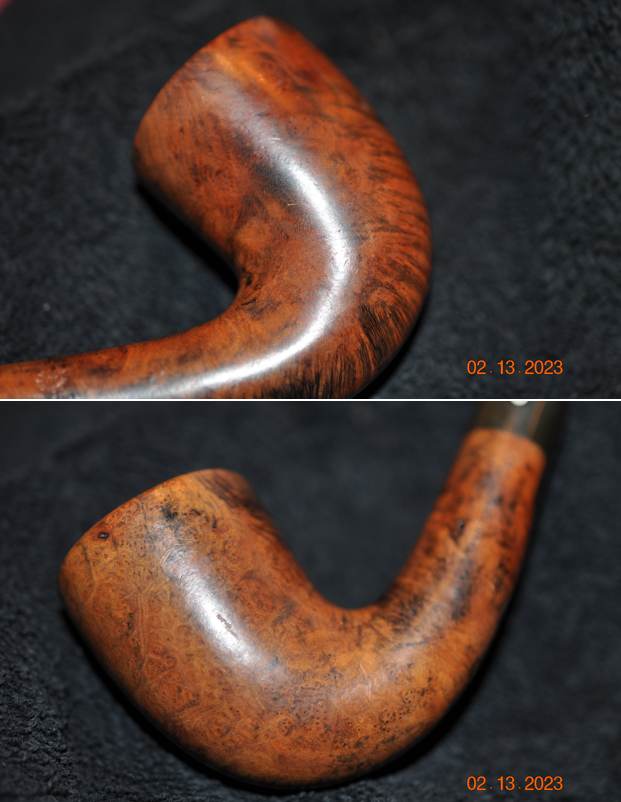
 I also ask him to take photos of the stamping so I can see if it is faint in any spots or double stamped or unclear. It often takes several photos to capture what I am looking for. The stamping on the left and right sides of the shank are relatively clear in the pictures below. On the left it reads COMOY’S [over] CHRISTMAS 1990. The stamping on the right side shows the COM (Country of Manufacture). It is a circular stamp with Made in London on the top and bottom side with “IN” placed in the centre. Underneath it is stamped London. There is no shape number on the pipe. The stamping on both side is readable and clear. It is slightly fainter next to the stem/shank joint. Jeff also included a photo of the inset stem logo – C. It is one piece C rather than the older 3 piece one which fits the date of the pipe. I was concerned that the C logo on the stem may have been a decal rather than an inlay but it appears to be inlaid.
I also ask him to take photos of the stamping so I can see if it is faint in any spots or double stamped or unclear. It often takes several photos to capture what I am looking for. The stamping on the left and right sides of the shank are relatively clear in the pictures below. On the left it reads COMOY’S [over] CHRISTMAS 1990. The stamping on the right side shows the COM (Country of Manufacture). It is a circular stamp with Made in London on the top and bottom side with “IN” placed in the centre. Underneath it is stamped London. There is no shape number on the pipe. The stamping on both side is readable and clear. It is slightly fainter next to the stem/shank joint. Jeff also included a photo of the inset stem logo – C. It is one piece C rather than the older 3 piece one which fits the date of the pipe. I was concerned that the C logo on the stem may have been a decal rather than an inlay but it appears to be inlaid. I did not take time to do work on the brand as it is a well known brand and the Christmas 1990 dates the pipe and the logo and stamping match that time period. If you would like to do some reading on it you can check both Pipephil’s site and Pipedia for a great write up on the history of the brand. I decided instead to just get to work on the pipe.
I did not take time to do work on the brand as it is a well known brand and the Christmas 1990 dates the pipe and the logo and stamping match that time period. If you would like to do some reading on it you can check both Pipephil’s site and Pipedia for a great write up on the history of the brand. I decided instead to just get to work on the pipe.
I am sure many of you skip my paragraph on the work Jeff has done before the pipe gets here in my many blogs but it is quite detailed in its brevity. I know some laugh at my opening line Jeff did a thorough cleaning of this pipe. However, I want you to know the details of the work. Back in 2020 Jeff wrote a blog about his cleaning process. I am including a link to that now so you can see what I mean about his process. Do not skip it! Give it a read (https://rebornpipes.com/2020/01/20/got-a-filthy-estate-pipe-that-you-need-to-clean/). Here is the introduction to that blog and it is very true even to this day.
Several have asked about Jeff’s cleaning regimen as I generally summarize it in the blogs that I post rather than give a detailed procedure. I have had the question asked enough that I asked Jeff to put together this blog so that you can get a clear picture of the process he uses. Like everything else in our hobby, people have different methods they swear by. Some may question the method and that is fine. But it works very well for us and has for many years. Some of his steps may surprise you but I know that when I get the pipes from him for my part of the restoration they are impeccably clean and sanitized. I have come to appreciate the thoroughness of the process he has developed because I really like working on clean pipe!
For the benefit of some of you who may be unfamiliar with some of the products he uses I have included photos of three of the items that Jeff mentions in his list. This will make it easier for recognition. These three are definitely North American Products so you will need to find suitable replacements or order these directly on Amazon. The makeup pads are fairly universal as we were able to pick some up in India when we were with Paresh and his family.
In the blog itself he breaks his process down into two parts – cleaning the stem and cleaning the bowl. Each one has a large number of steps that he methodically does every time. I know because I have watched him do the work and I have seen the pipes after his work on them. He followed this process step by step and when the pipe got to me it was spotlessly clean and ready for my work. The inside of the stem, shank and bowl were clean and to me that is an amazing gift as it means that my work on this end is with a clean pipe! I cannot tell you how much difference that makes for my work.
When the pipe arrives here in Vancouver I have a clean pipe and I go over it keeping in mind my assessment shared in the opening paragraph above. I am looking for any significant structural changes in the bowl and finish as I go over it.
- The dark streaks around the bowl and shank seemed to have been removed by Jeff’s scrubbing of the bowl and shank. He did not remove the dark stain that highlights the grain around the bowl but the clean finish is much better in displaying the grain. Polishing it will take care of the dullness and bring the briar back to life.
- The crowned rim top is clean and looks much better. Jeff was able to remove both the lava and dark streaks on the surface. There are some scratches on the right top of the rim toward the front of the bowl.
- The bowl was very clean and smelled clean. The clean walls did not show evidence of checking or cracking. There were no hot spots or damage on the walls or around the entrance of the airway into the bowl. It was clean and smooth which is great news for me. The inner edge of the bowl was undamaged and did not show any sign of burning or reaming damage to the edges of the bowl. Both the shank and the bowl were very clean showing no debris on a clean pipe clean run through them. I would need to give it a final cleaning with pipe cleaners and alcohol once I had finished with the external work to remove the debris that may have collected there in the process.
- The stem is vulcanite and has a single piece C inserted logo on the left side of the saddle portion. It is clearly inset in the stem not a decal.
- The oxidation was gone from the stem after Jeff’s work on it. The tooth marks and chatter will need to be dealt with once I finish the bowl.
Hopefully the steps above show you both what I look for when I go over the pipe when I bring it to the work table and also what I see when I look at the pipe in my hands. They also clearly spell out a restoration plan in short form. My work is clear and addressing it will be the next steps. I took photos of the whole pipe to give you a picture of what I see when I have it on the table. This is important to me in that it also shows that there was no damage done during the clean up work or the transit of the pipe from Idaho to here in Vancouver.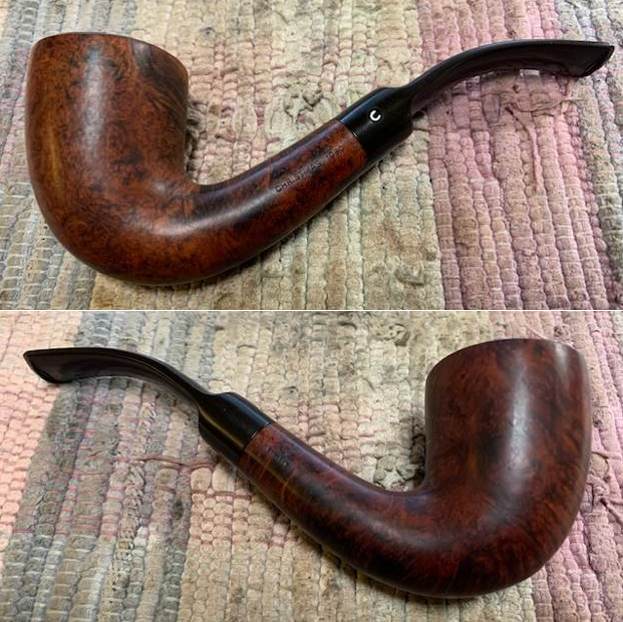
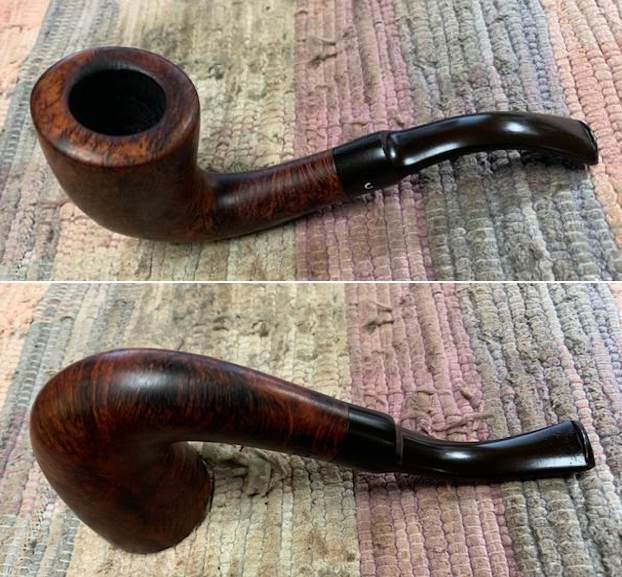 I then spent some time going over the bowl and rim top to get a sense of what is happening there. The bowl looked very good and the walls were smooth. There was no damage internally. The rim top was clean but there was darkening on the inner edge – particularly the right front. It looks to be burned but is not. There is also some scratching that I noted earlier that is also very visible on the entire right side. I also went over the stem carefully. There were dents in the stem that are visible in the photos. But the good news is that the tooth marks were not deep and did not seem to puncture the airway. They would clean up well. I examined the button edge and was happy to see that the marks there were not too bad and should be able to be sanded out. I took photos of the rim top and stem sides to show as best as I can what I see when I look at them.
I then spent some time going over the bowl and rim top to get a sense of what is happening there. The bowl looked very good and the walls were smooth. There was no damage internally. The rim top was clean but there was darkening on the inner edge – particularly the right front. It looks to be burned but is not. There is also some scratching that I noted earlier that is also very visible on the entire right side. I also went over the stem carefully. There were dents in the stem that are visible in the photos. But the good news is that the tooth marks were not deep and did not seem to puncture the airway. They would clean up well. I examined the button edge and was happy to see that the marks there were not too bad and should be able to be sanded out. I took photos of the rim top and stem sides to show as best as I can what I see when I look at them. I always check to make sure that the clean up work did not damage the stamping on the shank in any way. I know Jeff is cognizant of this but I do it anyway and take a photo to show what I see when I examine it. In this case it has not changed at all from the pictures I included above. I also remove the stem from the shank and check the tenon and lay the parts of the pipe out to get a sense of the proportion that was in the mind of the pipe maker when he crafted the pipe. It is a beauty in flow and shape.
I always check to make sure that the clean up work did not damage the stamping on the shank in any way. I know Jeff is cognizant of this but I do it anyway and take a photo to show what I see when I examine it. In this case it has not changed at all from the pictures I included above. I also remove the stem from the shank and check the tenon and lay the parts of the pipe out to get a sense of the proportion that was in the mind of the pipe maker when he crafted the pipe. It is a beauty in flow and shape. 
 As I pointed out in a previous blog, the question of where to begin the restoration work is always a matter of personal preference. If you read this blog much you will see that each of the restorers who post here all start at different points. Kenneth always starts with the stems, others as well do that. I personally like to start with the bowl because it gives me hope that this pipe is really a beauty. I said previously that I truly do not like the tedious work of stem repairs and stem polishing. I have been thinking about that and I think it is more it takes longer for slower results. I think that is why I always leave that until last even though I know that it needs to be done. So if you are restoring your pipes choose where you want to start and go from there. Just know that it all will need to be done by the end but for me the encouragement of seeing a rejuvenated bowl is the impetus I need to attack the stem work.
As I pointed out in a previous blog, the question of where to begin the restoration work is always a matter of personal preference. If you read this blog much you will see that each of the restorers who post here all start at different points. Kenneth always starts with the stems, others as well do that. I personally like to start with the bowl because it gives me hope that this pipe is really a beauty. I said previously that I truly do not like the tedious work of stem repairs and stem polishing. I have been thinking about that and I think it is more it takes longer for slower results. I think that is why I always leave that until last even though I know that it needs to be done. So if you are restoring your pipes choose where you want to start and go from there. Just know that it all will need to be done by the end but for me the encouragement of seeing a rejuvenated bowl is the impetus I need to attack the stem work.
Knowing that about me you can guess that I started working on this pipe by turning to the bowl. I chose to deal with the damage to the rim top and inner edge of the bowl. For this work I use a folded piece of 220 grit sandpaper to attack the inner edge and slight bevel. I work on it until it looks better and as much of the darkening and damage are removed as much as can be done without changing the profile of the crowned rim top. Remember to work all the way around the inner edge or you will cause the bowl to be out of round. You can see from the photos that the rim edges and top look better already. Polishing the briar will come next and that will smooth out these areas further.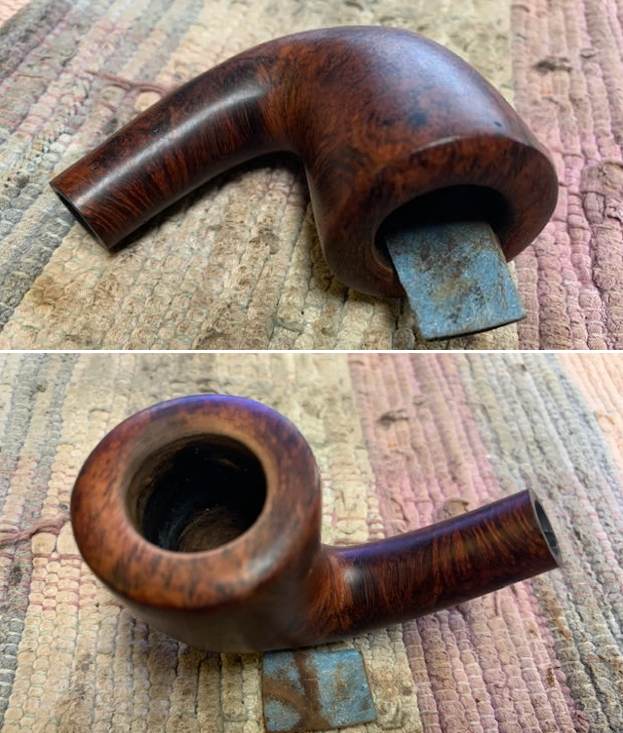 With the rim top looking better I turned to polishing the briar with micromesh sanding pads. I choose to dry sand the briar rather than wet sand it. Again it is a matter of personal preference. I prefer to use the pads dry and find they work very well on the briar. I sand with each pad (9 in total) and group them by threes for ease of reference. I wipe the bowl down with a damp cloth after each pad to remove the sanding debris and check the briar. I love seeing the developing shine on the briar as I move through the pads. I include the many photos of various angles of the bowl so you can see the change. Pay attention to the changes in the briar in these photos as you work through them.
With the rim top looking better I turned to polishing the briar with micromesh sanding pads. I choose to dry sand the briar rather than wet sand it. Again it is a matter of personal preference. I prefer to use the pads dry and find they work very well on the briar. I sand with each pad (9 in total) and group them by threes for ease of reference. I wipe the bowl down with a damp cloth after each pad to remove the sanding debris and check the briar. I love seeing the developing shine on the briar as I move through the pads. I include the many photos of various angles of the bowl so you can see the change. Pay attention to the changes in the briar in these photos as you work through them.
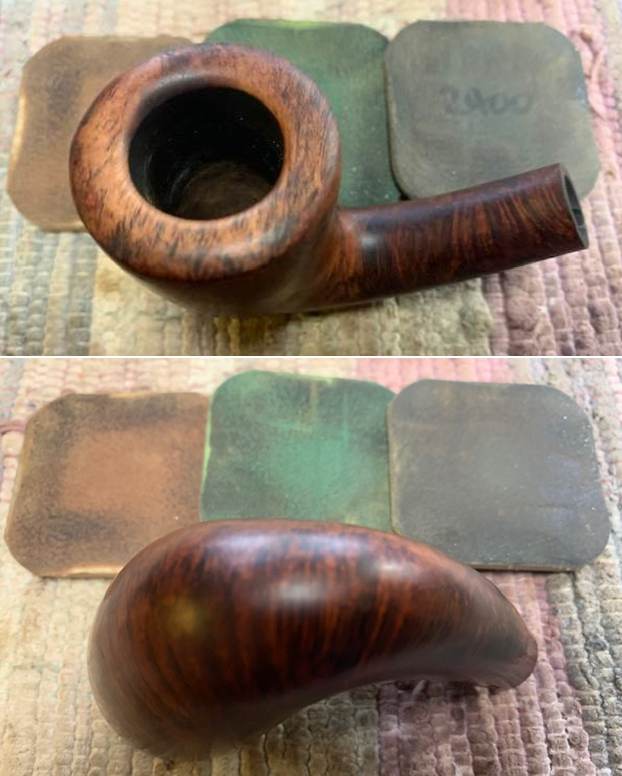
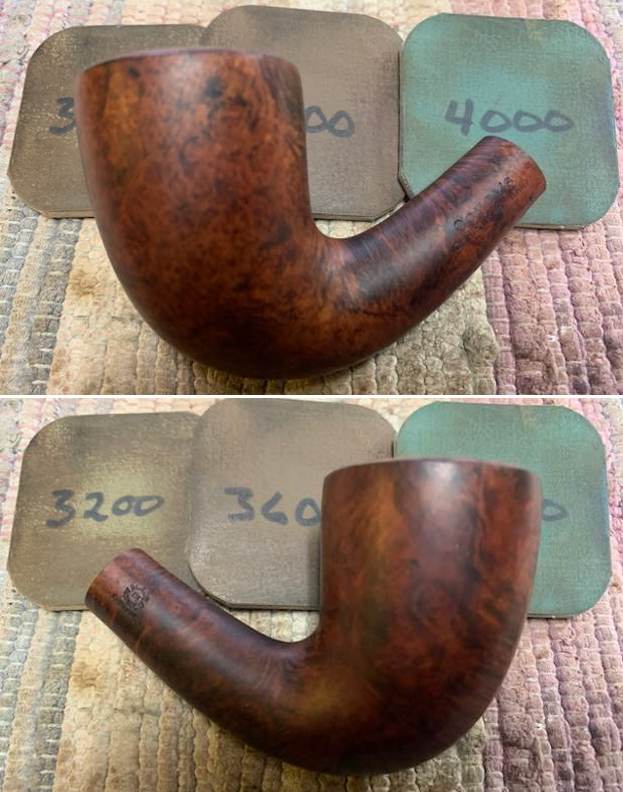

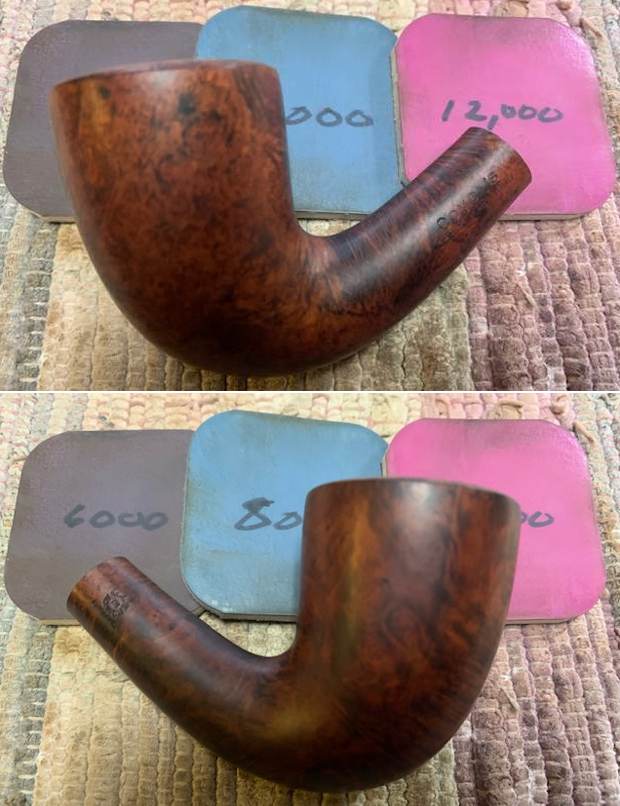
 When I get the bowl to this point in the process I use a product developed by Mark Hoover called Before & After Restoration Balm. It is a paste/balm that is rubbed into the surface of the briar. The product works to deep clean the finish, enliven and protect the briar. I worked it into the briar with my finger tips to make sure that it covers every square inch of the pipe. I set it aside for 10 minutes to let it do its work. Once the time has passed I wiped it off with a soft cloth then buffed it with a cotton cloth. The briar really began to have a deep shine. The photos I took of the bowl at this point mark the progress in the restoration. You see the shine that the briar has taken on and the way the grain just pops. It is a gorgeous pipe.
When I get the bowl to this point in the process I use a product developed by Mark Hoover called Before & After Restoration Balm. It is a paste/balm that is rubbed into the surface of the briar. The product works to deep clean the finish, enliven and protect the briar. I worked it into the briar with my finger tips to make sure that it covers every square inch of the pipe. I set it aside for 10 minutes to let it do its work. Once the time has passed I wiped it off with a soft cloth then buffed it with a cotton cloth. The briar really began to have a deep shine. The photos I took of the bowl at this point mark the progress in the restoration. You see the shine that the briar has taken on and the way the grain just pops. It is a gorgeous pipe.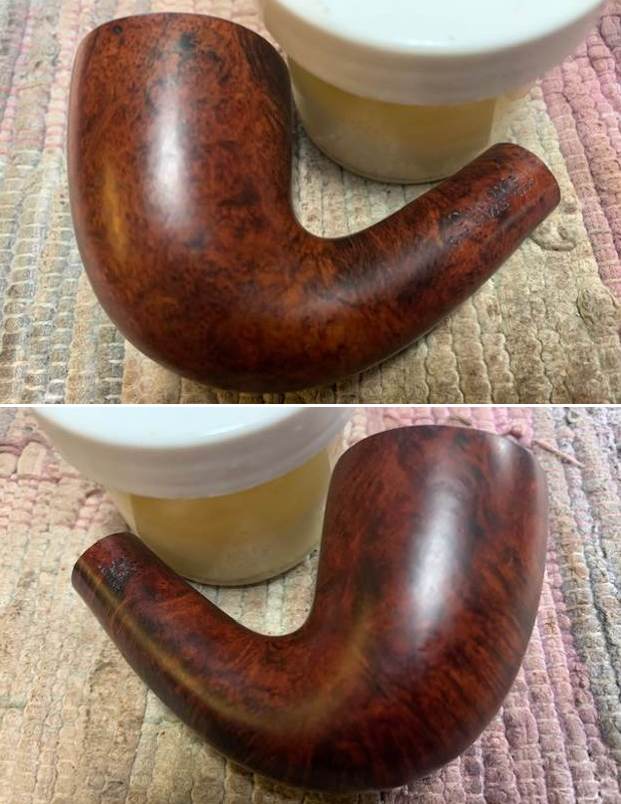

 Now it was time to address the part of the restoration I leave until last. I set the bowl aside and turned my attention to the stem. The stem was in quite good shape. Jeff had been able to remove the oxidation so that when it came it looked pretty good. It was time to address the tooth marks. When the damage is quite shallow and not imposing I flatten it out with 220 grit sandpaper and start polishing it with 600 grit wet dry sandpaper to remove the scratches. This process makes the repairs almost invisible when polished and also takes care of scratching in the surface of the vulcanite. That is what I did in this case and it worked well. This stem was quite painless so I guess I could have started with it but ah well old habits are hard to change. Here are photos of the stem after the sandpaper work.
Now it was time to address the part of the restoration I leave until last. I set the bowl aside and turned my attention to the stem. The stem was in quite good shape. Jeff had been able to remove the oxidation so that when it came it looked pretty good. It was time to address the tooth marks. When the damage is quite shallow and not imposing I flatten it out with 220 grit sandpaper and start polishing it with 600 grit wet dry sandpaper to remove the scratches. This process makes the repairs almost invisible when polished and also takes care of scratching in the surface of the vulcanite. That is what I did in this case and it worked well. This stem was quite painless so I guess I could have started with it but ah well old habits are hard to change. Here are photos of the stem after the sandpaper work.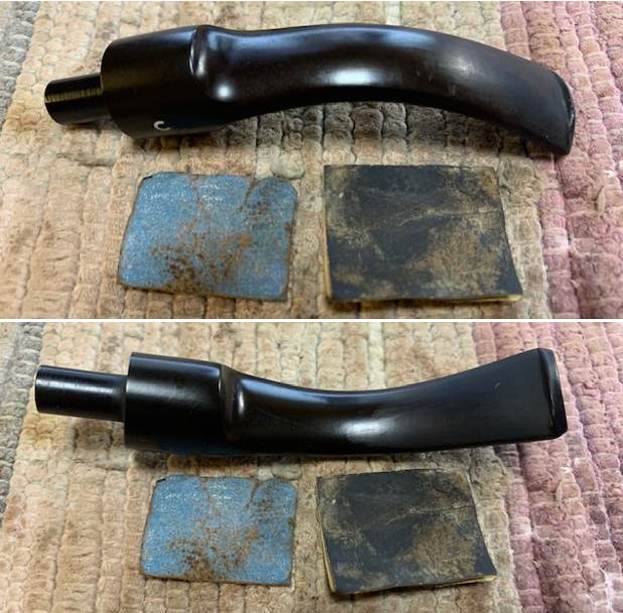 It was the time now to polish the stem and bring back a shine. Over the years I have developed my own process for this. It is all preparation for the buffing that will come last. I use micromesh sanding pads and water to wet sand the stem with 1500-12000 grit sanding pads. I wiped it down after each sanding pad with Obsidian Oil on a cotton rag after each sanding pad as I find it does two things – first it protects the vulcanite and second it give the sanding pads bite in the polishing process.
It was the time now to polish the stem and bring back a shine. Over the years I have developed my own process for this. It is all preparation for the buffing that will come last. I use micromesh sanding pads and water to wet sand the stem with 1500-12000 grit sanding pads. I wiped it down after each sanding pad with Obsidian Oil on a cotton rag after each sanding pad as I find it does two things – first it protects the vulcanite and second it give the sanding pads bite in the polishing process.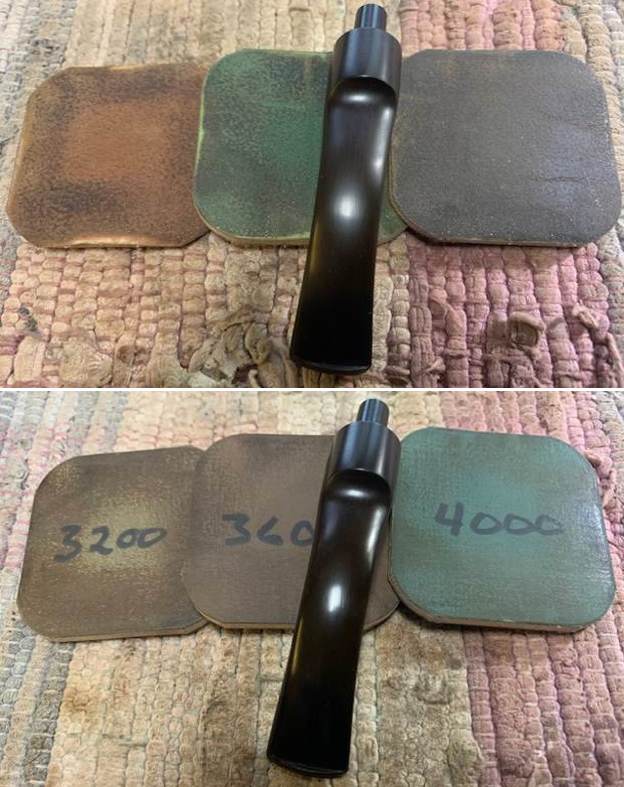
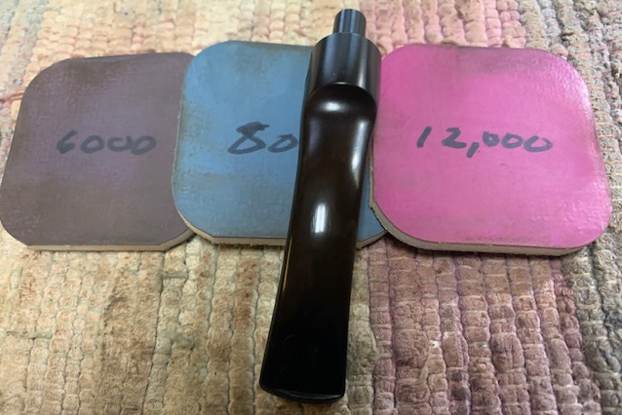 After finishing with the micromesh pads I always rub the stem down with Before & After Fine and Extra Fine stem polish as it seems to really remove the fine scratches in the vulcanite. I rub the Fine Polish on the stem and wipe it off with a paper towel and then repeat the process with the Extra Fine polish. I finish the polishing of the stem by wiping it down with a final coat of Obsidian Oil and set the stem aside to let the oil absorb. This process gives the stem a shine and also a bit of protection from oxidizing quickly.
After finishing with the micromesh pads I always rub the stem down with Before & After Fine and Extra Fine stem polish as it seems to really remove the fine scratches in the vulcanite. I rub the Fine Polish on the stem and wipe it off with a paper towel and then repeat the process with the Extra Fine polish. I finish the polishing of the stem by wiping it down with a final coat of Obsidian Oil and set the stem aside to let the oil absorb. This process gives the stem a shine and also a bit of protection from oxidizing quickly. The final steps in my process involve using the buffer. I first buff the stem and the briar with Blue Diamond on the buffing wheel. Blue Diamond is a plastic polish but I find that it works very well to polish out the light scratches in the vulcanite and the briar. I work the pipe over on the wheel with my finger or thumb in the bowl to keep it from becoming airborne. It works well and I am able to carefully move forward with the buffing. I lightly buff the plateau on the rim top and shank end at the same time making sure to keep the product from building up in the grooves of the finish.
The final steps in my process involve using the buffer. I first buff the stem and the briar with Blue Diamond on the buffing wheel. Blue Diamond is a plastic polish but I find that it works very well to polish out the light scratches in the vulcanite and the briar. I work the pipe over on the wheel with my finger or thumb in the bowl to keep it from becoming airborne. It works well and I am able to carefully move forward with the buffing. I lightly buff the plateau on the rim top and shank end at the same time making sure to keep the product from building up in the grooves of the finish.
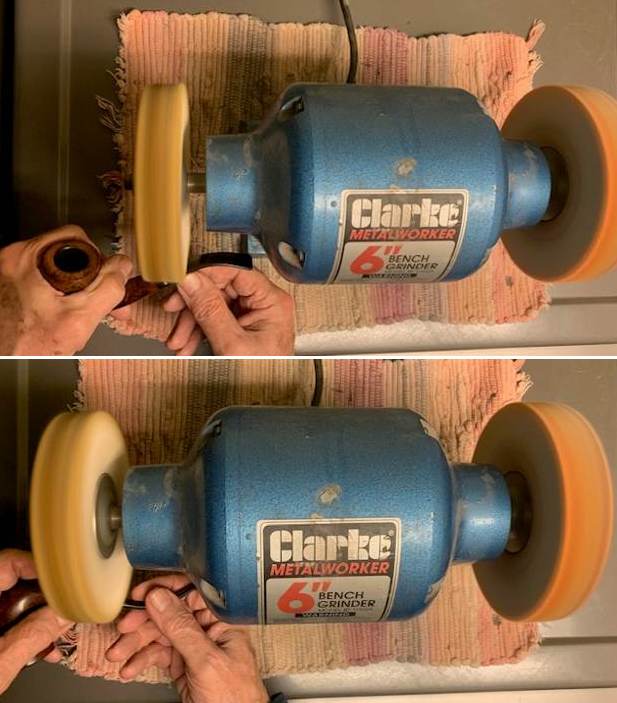 I finished with the Blue Diamond and moved on to buffing with carnauba wax. Once I have a good shine in the briar and vulcanite I always give the bowl and the stem multiple coats of carnauba wax. I have found that I can get a deeper shine if I following up the wax buff with a clean buffing pad. It works to raise the shine and then I follow that up with a hand buff with a microfiber cloth to deepen the shine. It is always fun for me to see what the polished bowl looks like with the polished vulcanite stem. It really is a beautiful pipe. The smooth finish around the bowl sides and shank show the grain shining through the rich brown stains of this Comoy’s Christmas 1990 Bent Calabash and the polished vulcanite stem is a great addition. The finished pipe feels great in my hand. It is light and well balanced. Have a look at it with the photos below. The dimensions are Length: 6 inches, Height: 2 ¼ inches, Outside diameter of the bowl: 1 ½ inches, Chamber diameter: 7/8 of an inch. The weight of the pipe is 1.83 ounces/52 grams. It is a beautiful pipe and one that I will be putting on the rebornpipes store in the British Pipe Maker section.
I finished with the Blue Diamond and moved on to buffing with carnauba wax. Once I have a good shine in the briar and vulcanite I always give the bowl and the stem multiple coats of carnauba wax. I have found that I can get a deeper shine if I following up the wax buff with a clean buffing pad. It works to raise the shine and then I follow that up with a hand buff with a microfiber cloth to deepen the shine. It is always fun for me to see what the polished bowl looks like with the polished vulcanite stem. It really is a beautiful pipe. The smooth finish around the bowl sides and shank show the grain shining through the rich brown stains of this Comoy’s Christmas 1990 Bent Calabash and the polished vulcanite stem is a great addition. The finished pipe feels great in my hand. It is light and well balanced. Have a look at it with the photos below. The dimensions are Length: 6 inches, Height: 2 ¼ inches, Outside diameter of the bowl: 1 ½ inches, Chamber diameter: 7/8 of an inch. The weight of the pipe is 1.83 ounces/52 grams. It is a beautiful pipe and one that I will be putting on the rebornpipes store in the British Pipe Maker section.
Hopefully this tack of writing this blog is helpful to you in some way. In it I show both what I am looking for and how I move forward in addressing what I see when work on a pipe has been helpful to you. It is probably the most straightforward detailed description of my work process. As always I encourage your questions and comments as you read the blog. Thanks to each of you who are reading this blog. Remember we are not pipe owners; we are pipemen and women who hold our pipes in trust until they pass on into the trust of those who follow us.
